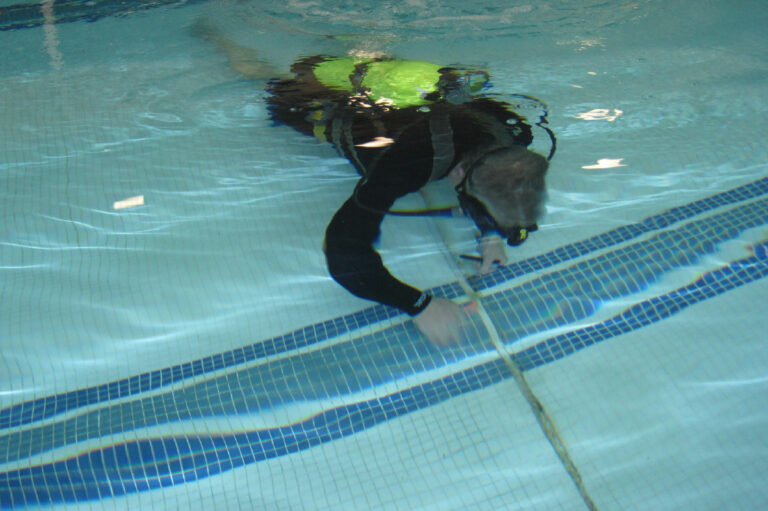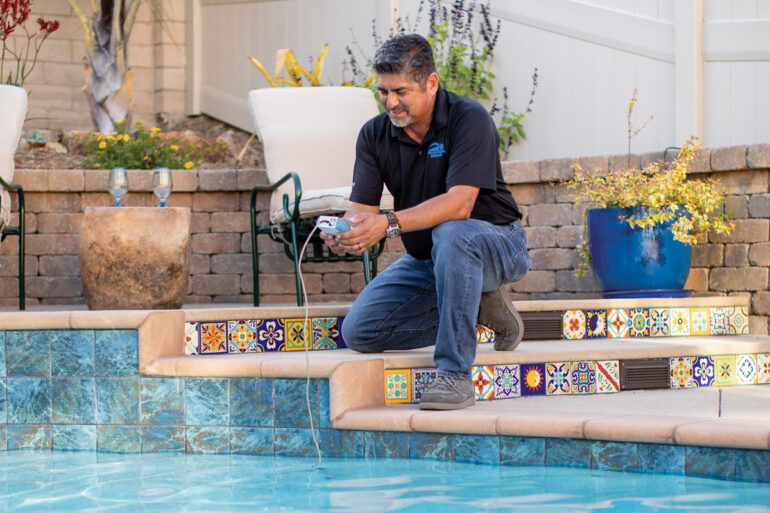Light It Up

Best practices for replacing pool lights
Changing a light bulb in a pool can be tough.
While DIY internet advice abounds, a pool professional can bring the experience needed to each unique job that tutorials can’t.
Bob Buettner, field development and training manager for National Pool Partners, says in addition to lacking the experience of a professional, the customer may not have the tools they need. What takes a pro half an hour could take the customer hours on their own.
“Someone who’s never done a tuneup on a car or worked on a transmission shouldn’t start today,” Buettner says. “Anytime you’re dealing with electrical, you want to have a professional do it.”
Someone who’s never done a tuneup on a car or worked on a transmission shouldn’t start today. Anytime you’re dealing with electrical, you want to have a professional do it.”
Bob Buettner, National Pool Partners
Buettner points out that upon inspection, an entire light fixture may need to be replaced, which is a more involved process than a light bulb change.
Joey Busic Jr., repair technician for Precision Aquatics in Oceanside, California, highlights manufacturer warning labels that usually accompany lighting products and notes the possibility of serious injury or death if the light is not installed or used correctly.
“It almost always follows with a ‘For installation, please do so with an experienced professional,’ ” Busic Jr. says.
Aden Dunne, owner of Classic Pools and Spas in Carlsbad, California, says his team curbs DIY enthusiasm by helping customers see the value in hiring a professional.
“The main thing we point out is the warranty and peace of mind knowing that the name-brand product came from a reputable source,” Dunne says.
Pool pros who are familiar with best practices bolster their reputation and provide confidence for pool owners.
Taking inventory of the tools and gear on hand is the first step in prepping for a lighting service call. Buettner recommends keeping these ready:
- Poly pull line
- Electrician fish tape
- Dish soap
- Phillips-head screwdriver
- Flathead screwdriver
- Knife and pliers
- Clean, soft cloth
- Electrical tape
- Wire strippers/cutters
- Voltage tester
Buettner also says a pool light wedge tool can be helpful if the niche screw hole threads are stripped or the light adapter ring is damaged.
Busic Jr. and Buettner say some kind of pull tape — like fish tape or mule tape — is a must for pulling wires and cables.
Busic Jr.’s team uses mule tape, which can function as a threading line, measuring tape and winchline.
“If you aren’t familiar with mule tape, familiarize yourself,” Busic Jr. says. “We love the printed footage; it makes it so easy for exact cord length.”
After identifying the correct light conduit, the wire insulation is cut off 3-5 inches, Busic Jr. says, exposing the copper wire strands. They’re twisted together and the copper is pushed through a small hole in the mule, tied together and secured with electrical tape. Dish soap is dumped down the conduit as a lubricant to help with the pull. The mule tape is slowly unraveled which pops out on the other end and allows them to pull the new light in reverse order.
“It helps to take the old light and roll out the new light and cut them to the exact length so you’re not pulling extra cord and wasting time,” Busic Jr. says.
The first thing to do when servicing a light is to turn off the power, and Buettner recommends bringing a voltage tester to double-check for mismarked breakers.
“I’ve checked lights at pools and the breaker was marked for the pool light and it wasn’t the pool light,” he says.
Buettner reminds pros to regularly test the light’s ground fault circuit interrupter and check the condition of the fixture.
“Make sure you know that the fixture itself is not corroded where you couldn’t see it,” Buettner says. “Once you take the lens off the cover, you can see if there’s any moisture in there, and if there’s moisture, it’s been leaking.”
If it’s been leaking, it will continue to leak and the fixture can warp over time, so the whole fixture needs to be replaced, not just a new light bulb, he says.
Buettner also stresses knowing the voltage of the fixture and bulb, as a 12-volt bulb requires a transformer to step down the standard 120-volt power supply to a safer 12-volt level.
“The brightness is the same for both types, but the bulbs are not interchangeable,” he says.
Buettner’s tips for handling an incandescent light bulb include never testing the light fixture outside the water.
“If the water’s not outside of it, cooling it, it can actually blow the lens,” he says.
He also advises never handling an incandescent or halogen bulb with bare hands. Using a paper towel or soft cloth will prevent skin oils from being left on it, which can end up popping the bulb when it’s hot.
Encouraging customers to switch to LED lighting is also recommended, and Dunne says showing the comparison in power usage, cost savings, color options and life expectancy with LED lighting helps customers overcome sticker price shock.
“If you’re a swimmer or pool tech, you need to see the whole pool from a safety standpoint,” Buettner says. “The industry has responded and come up with all these great ideas. Everything, including lights, are more energy efficient, brighter and more colorful. It’s gotten so much better, and I’m really glad to be part of it.”






